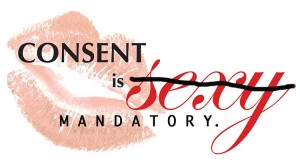We have all heard that a so-called “gray area” exists around sexual consent and rape — that sometimes it’s unclear as to whether each party is consensually participating in an act of sex, but that certain actions, clothing, or conversations invite sex and signal consent.
This is just not true.
This “gray area” is the result of a few different working parts and understanding their origin can help us understand how they play out in our everyday lives.
Distancing yourself from their harmful grip is an important part of developing a healthy sexuality for women, men and any other gender-identified people.
Where Does the “Gray Area” Come From?
The topic of consent is typically missing from the sex ed talks we receive at school, home, or a doctor’s office. If we’re lucky, we do learn about STIs, STDs, and contraception from a teacher, family member or doctor.
But the vast majority of us never hear about the issue of consent when we’re being formally introduced to the practice of healthy sex and sexuality.
The most prominent models for learning about consent are movies, television, and porn. Not the greatest source of healthy sexuality education, to put it mildly.
The central tenant of consent that we take away from these inadequate learning experiences is: Guys, no means no! Listen to women.
This is problematic for several reasons. First, it limits consent to a purely heterosexual issue. This excludes same-sex partners and queer people from the cultural and educational conversation about consent. It also ignores the presence of sexual violence in the queer community.
Second, it positions men as the gatekeepers of consent and sets up a power dynamic that undermines consent as an ongoing conversation between two partners.
It’s important to realize that we all come to the negotiation of consent with a lifetime of internalized experiences relating to consent. For example, we learn as girls and teenagers to tolerate boundary violations and micro-aggressions like catcalling, bra-snapping, butt pinching, and other unwanted attention in the name of boys having good old fun.
Furthermore, encouraged styles of communication vary greatly between girls and boys, women and men. Being polite, sweet, and unassuming is the most acceptable style of communication for women and girls to practice, while being loud, forceful and confident is the most glorified type of communication for men and boys to practice. It is no surprise that men are traditionally positioned in a place of power as the gatekeepers of consent.
Another huge factor in the existence and popularity of the “gray area” myth is that it lets rapists off the hook. If a lack of clarity around consent is normalized, rape can be excused as an accident —merely a misunderstanding.
It’s difficult to “unlearn” the things we’ve been taught by society, but removing the “gray area” from sex simultaneously removes a lot of anxiety from the experience, allows you and your partner to be honest and open with each other, and makes sex far more enjoyable overall.
Where Do We See the “Gray Area”?
The “gray area” we have come to know as an inevitable part of sex and consent is a product of our culture’s less than healthy or communicative approach to sex.
But the reality is that this murky confusion does not have to and should not exist. A great way to spark a shift in the way we think about sex and consent is to look at the common ways the “gray area” myth plays out.
How the “Gray Area” Myth Wrongly Assumes Consent
Here are some common examples of when consent is inferred or assumed where it does not exist. It’s important to note that while women are disproportionately affected by rape, both men and women perpetuate myths about consent and have sex in the absence of enthusiastic consent.
1. “Did you see how short her dress was? She was asking for sex.”
Sometimes women’s outfits, particularly ones that reveal a lot of skin, are perceived as an invitation for sex or a signal of pre-consent.
The truth is that someone’s choice in dress NEVER invites unwanted sexual attention or rape. There is not one single thing that a person can do to “ask” to be raped. It’s a dress, not a yes.
True consent is enthusiastic consent—a deliberate and thoughtful process—not something that can be interpreted.
Think of enthusiastic consent as an active and ongoing process of willingly and freely choosing to participate in any act of sex with someone else.
Each person involved equally participates in the process and feels comfortable to make and communicate any choice or feelings without feeling pressured, manipulated, or afraid.
The “she was asking for it” myth is a spinoff of the gray area myth—it works to place the blame on rape victims instead of rapists and perverts true consent. Don’t be fooled by this myth, ladies and gentlemen.
2. “She was flirting with me SO much. She was totally asking for sex.”
Flirting and acting romantically interested in someone is commonly interpreted as a desire to have sex. For the same reasons a woman’s outfit is never a signal of consent, flirting is never a signal of consent.
It may mean that she’s interested in you. But whether or not she wants to have sex with you is an entirely different question. It’s possible that she does want to have sex, but you need to check in and ask about it and not jump to any assumptions.
3. “We’re dating so I can have sex with them whenever I want.”
Many people in relationships assume that their relationship status translates into a permanent state of consenting to sex.
But just because you’re dating someone doesn’t mean you have a free ticket to have sex with them whenever you want.
Consent should be thought of as an ongoing process and conversation—just because you’ve given consent once, are in a relationship with someone, or even married to them does not mean that you are obligated to have sex with your partner.
Jaclyn Friedman, co-editor of Yes Means Yes, explains the active nature of here:
“Sexual consent isn’t like a lightswitch, which can be either “on” or “off.” It’s not like there’s this one thing called “sex” you can consent to anyhow. “Sex” is an evolving series of actions and interactions. You have to have the enthusiastic consent of your partner for all of them. And even if you have your partner’s consent for a particular activity, you have to be prepared for it to change. Consent isn’t a question. It’s a state.”
A partner may give consent without desire because they feel obligated to or because they don’t feel confident enough to speak up. Consent without desire cannot be considered consent if an underlying and unspoken pressure or obligation exists.
At the same time, consent can be given without the person feeling really sexually excited themselves. This may happen, for example, if they are doing it primarily to give pleasure to their partner or to build up the low level of sexual desire. As long as there’s no feeling of pressure and coercion, while it may not be full throttle enthusiastic consent, it can still be given in this situation.
4. “They kept saying ‘no’ but eventually said ‘yes’.”
Because many people are taught to think about consent in an “all you need is a yes” way, consent can be approached as an end goal—something you can pressure someone to eventually agree to.
The commonality of this sexual experience—being pressured into seemingly “consenting”—is astounding and many people do not realize that this is not consent at all.
Pressure to engage in a sexual act one does not wish to, either aggressive or calm and persistent, crumbles the platform on which true consent can be communicated freely and honestly.
Badgering, guilt-tripping, or pressuring someone until an initial “no” becomes an “okay” or “yes” is not actually a consensual yes.
It is rape.
5. “They didn’t say ‘no’…”
Silence, “ouch,” or “maybe…” are interpreted by some as expressions of consent because a defined and clear “no” wasn’t uttered.
A lack of “no” is not a “yes.” Assumed or inferred consent is not consent.
An “Okay, I guess” is not a yes. It’s important to not use or base your actions off of vague language when communicating about sex and intimacy.
6. “We were both wasted, but we both really wanted it.”
Having sex while intoxicated certainly isn’t uncommon and that’s why it’s important to understand that while you’re drunk, it’s difficult to negotiate consent honestly and clearly.
Being drunk, asleep, or under severe duress—like grief and extreme sadness are situations in which full, informed and free consent cannot be fully or truly given.
Alcohol or experiencing strong emotions make communication difficult, both communication with oneself about desire and needs as well as with someone else about consent.
What Now?
To evolve as better partners and accountable individuals, we must begin to recognize instances in which consent is being assumed where it does not exist. We must also talk, listen, and hold ourselves to a high standard of sexual communication—the only way to ensure truly consensual sexual experiences.
In what other instances have you noticed “gray area” being created to infer consent where it does not exist? Please share below in the comments.
[do_widget id=”text-101″]
Sara Alcid is a Contributing Writer for Everyday Feminism and is a young feminist living and working in Washington, DC as a reproductive health and justice advocate. Sara loves thinking, reading and writing about the socially and personally transformative power of feminism, queer issues, and women’s health. Follow her on Twitter @SaraAlcid.
Search our 3000+ articles!
Read our articles about:
Our online racial justice training
Used by hundreds of universities, non-profits, and businesses.
Click to learn more





















